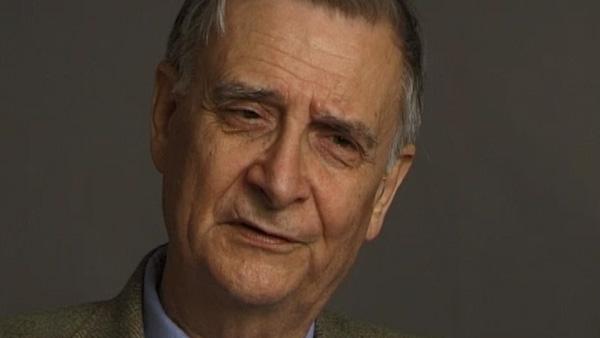NEXT STORY

Eating a big green katydid
RELATED STORIES

NEXT STORY

Eating a big green katydid
RELATED STORIES


|
Views | Duration | |
|---|---|---|---|
| 1. I never grew out of my bug period | 6 | 657 | 05:04 |
| 2. 'If you don't like mathematics, don't give up' | 2 | 839 | 02:59 |
| 3. A grand tour with Thomas Eisner | 1 | 296 | 05:23 |
| 4. Eating a big green katydid | 78 | 02:57 | |
| 5. Discovering ant colonies | 218 | 05:05 | |
| 6. Why I study ants | 362 | 01:09 | |
| 7. The Ants | 249 | 03:05 | |
| 8. Our book receives the Pulitzer Prize | 1 | 231 | 02:18 |
| 9. Fieldwork is exhilarating | 196 | 03:07 | |
| 10. The truly grand experience of my career | 207 | 06:09 |

One of the formative experiences of my life, actually I think I had a whole series of them, particularly since I was active in natural history from childhood onwards, so I had a lot of opportunity to see a lot and experience a lot in nature that probably is not easily available to an average young person in the United States, and certainly in Europe. It was a grand tour of the United States that I took in the summer of 1952 with Thomas Eisner, my close friend, and a great entomologist. And we were quite young at that time. And we decided the very thing to do was to get a car, fortunately Tom had one, and to simply travel all around the United States and visit practically every kind of habitat and see the world from the eyes of insect collectors. And there was a grand collecting adventure, sort of a miniature equivalent of travelling across Africa looking for all sorts of insects. I was particularly looking for ants and Tom was looking for some neuroptrous insects and others, and generally speaking Tom was just exploring at the beginning of his own career on chemical communication and chemical ecology, for which he was to be one of the founders.
Well, it was quite an adventure because we travelled 12,000 miles, we travelled on nothing, almost no money. We had a car, that is Tom had a car which he named 'Charrúa 2' after the Amerindians of Uruguay. It's where he had grown up in Montevideo. And that car today, if you took it out on the road, would probably result in a five year prison sentence just for having it on the road, it was coming apart. It required oil changes, it appeared to me, every time we took another bend in the road. It was just a constant headache. But the thing got us all the way around the United States. Some of the great national parks, some of the great southern habitats through the Louisiana Swamps, into the mountains of Appalachia and so on. It was a great trip.
And we soon divided labour. One had to cook and one had to clean the dishes. And I discovered one of Tom's weaknesses. That is he rather liked cooking, at least he didn't mind cooking. And the other thing I observed was that cooking took longer than cleaning dishes. And I'm an A type personality, I think he is too, but I'm a real A type personality. So I wanted to spend as little time connected with the meal as possible on this trip. Therefore I gladly relinquished the cooking to him. There were meals at which I came to regret that, but it was all right anyway. And because I could do the slapdash job of cleaning, and that way we managed to get along for this whole trip.
I guess there were a couple of memorable experiences from my point of view. One of them was when we stopped in... at one locality crossing the upper peninsula of Michigan, I encountered the worst swarm of biting flies I have ever encountered in my life. And believe me, I've been around. I've been in places in the tropics, you know, where they are legendary. Things that bite and suck blood from you. But here in Upper Michigan, in probably June, we encountered the following within just a couple of hours in our little camp site. We were inundated by black flies, this was black fly season. Very annoying insects. Also called buffalo gnats. We had swarms and swarms of Ceratopogonidae midges, also known as no-see-ums because they can go right through a screen they're so small, and they're hard to see, but you sure can feel them while they're sucking your blood. We had those all over the place. And then we had, of course, mosquitoes in great abundance, probably a couple of species, hitting us in the woods, hitting us in the fields, you know, each species adapted to a different environment to go after us. And then there were the greenheads, or the horseflies. Big buzzing flies that if you were incautious enough to let one alight on you, even on thin shirtsleeves and get their daggers into you, you suffered from that. Although there is no greater pleasure on God's green earth, I think, than letting one of these voracious and evil flies light on you, and squashing it. Well, never mind.
EO Wilson (1929-2021) was an American biologist, researcher (sociobiology, biodiversity), theorist (consilience, biophilia), naturalist (conservationist) and author (two Pulitzer Prizes). His biological specialty was myrmecology, the study of ants.
Title: A grand tour with Thomas Eisner
Listeners: Christopher Sykes
Christopher Sykes is a London-based television producer and director who has made a number of documentary films for BBC TV, Channel 4 and PBS.
Tags: Appalachia, Louisiana Swamps, Montevideo, Amerindians, Charrúa, Tettigoniidaen katydids, Thomas Eisner
Duration: 5 minutes, 23 seconds
Date story recorded: 2000
Date story went live: 22 May 2018